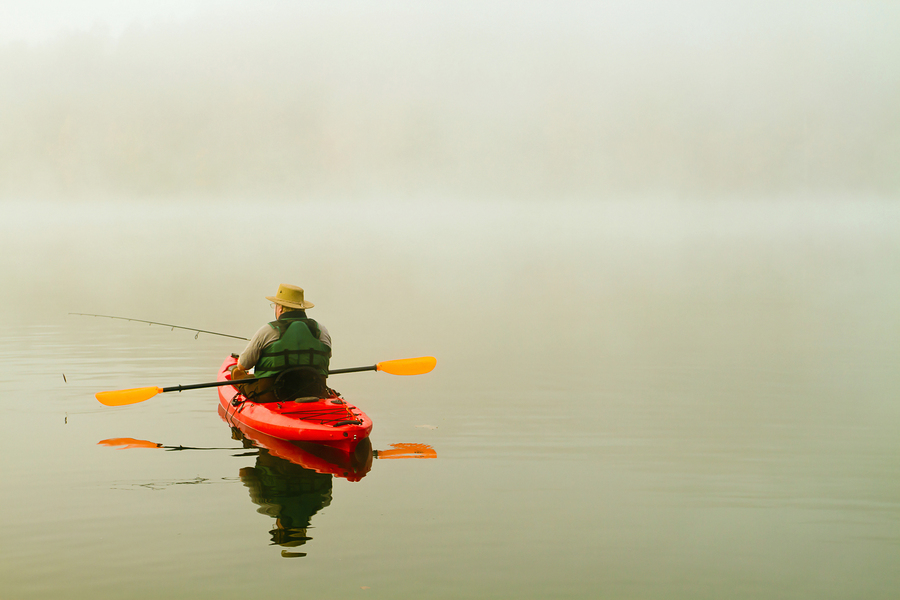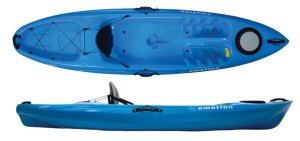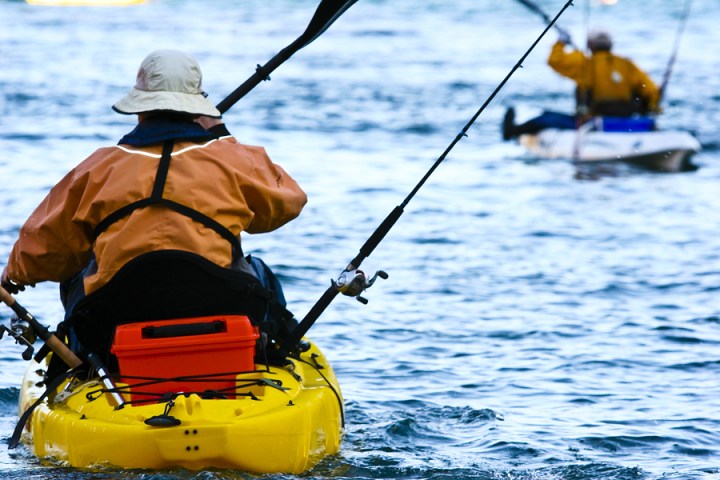Kayak Fishing provides unfettered access to some of the best bodies of water. The kayak, or yak as it is sometimes referred, is a maneuverable craft that has a very minimal impact on the environment, and allows anglers to get to areas that are restricted to motor boats, or simply inaccessible by larger types of craft.
Kayaks also allow anglers to approach fish quietly, which can be very advantageous to loud motor boats. Kayak fishing is a rewarding and challenging sport to experience. The physical act of using one's body to paddle across the water, and casting from a seated position, adds a formidable yet rewarding dynamic to the fishing experience.
Check out this post on kayak fishing pros and cons.
Anglers use kayaks in both fresh and saltwater environments. Kayaks can be effective in everything from backwoods lakes to choppy coastal surf. They come in a variety of different lengths and widths to suit different body sizes. The kayak's dimensions will also determine its speed and maneuverability, two important factors to consider depending on where you are fishing. The longer the boat, the more stable the ride (important for fishing beyond the surf in the ocean). The shorter it is, the more maneuverable it will be on the water (useful for river fishing and banks with overhanging trees and rocks).
Choosing the Right Boat
Fishing kayaks come in two varieties: sit-ins and sit-on-tops. The latter has an exposed seat that sits above the surface of the water. Sit-on-top kayaks are commonly preferred by anglers, because they provide a higher casting position, and allow for easy self-rescue in case of a spill. Sit-in Kayaks have seats on the bottom of the boat inside the craft's hull. This type can be harder to cast from, and move around in, because you will be limited to your torso movement. Although, kayakers can use spray skirts, which cover the inside top of the exposed hull, and protect the paddler from water.
Saltwater vs. Freshwater Kayak Fishing
Kayaks can go on just about any type of body of water. A kayak that's used for freshwater can also be used in saltwater environments; however, their performance might not crossover. When kayaking in coastal areas, anglers tend to use longer kayaks, because they stay more stable and straight when paddling. Consider the physical strength it takes to propel a boat with a double-sided paddle. Efficiency and forward momentum are both critical.
Shorter kayaks are king in smaller waters, because they are lighter and more agile. Kayak fishing allows anglers to get up close to great fishing spots that are often inaccessible areas of a river bank. In such settings, you'll want a kayak that is maneuverable, and open enough to easily reach your tackle.
New kayaks range anywhere from a few hundred to a couple thousand dollars. Great deals on used kayaks are readily available online on sites like eBay and Craigslist. Often times, consumers will purchase a brand new kayak, use it only a few times. As a result, you can find several used kayaks that are in good to excellent condition.
On Board-Storage
Kayaks are smaller craft, so having enough space for your gear is important. You should be able to grab what you need within an arm's reach or a forward or backward lean. The best fishing kayaks have a dry storage space lid near the stern. Most modern fishing kayaks have seats with Velcro pockets and holders for handy items, such as pliers, knives and tackle.
Check out this GoPro footage of fishing from a sit-on-top
Essential Equipment
In general, the same rod and reel combinations, bait and lures used for different types of fishing are the same when fishing from a kayak. The essential equipment you must look into are more specific to the actual sport of kayaking. The following list will give you a sense of what gear you'll need to create a basic kayak fishing gear rig.
Pole Holders - Absolutely essential for keeping your hands free, as well as paddling and trolling. They come in a variety of styles with single or multiple mounts.
Personal Floatation Device (PFD)- You should always wear a PFD when you are on the water, especially if you are fishing in ocean surf and beyond.
Paddle - Get a paddle that fits your height and torso width. Persons under 5-foot-2-inches should use a paddle between 188-194 cm; paddlers between 5' 2"-5'8" should use 191-197 cm; and paddler 5'9" and up should use a 194-200 cm paddles. Most paddles also expand in the middle to account for torso size.
Dry Bags - Essential for keeping items such as clothes, med kits. food and extra batteries dry.
Landing Nets - A typical item for any kayak fishing experience. You'll want to be able to snag your fish.
Additional Equipment
Kayak fishing does call for some additional gear for your boat to be successful on the water. The main items to consider are:
Pole Holders - Absolutely essential for keeping your hands free, as well as paddling and trolling. They come in a variety of styles with single or multiple mounts.
Personal Floatation Device (PFD)- You should always wear a PFD when you are on the water, especially if you are fishing in ocean surf and beyond.
Paddle - You're going to need one of these to get around. Make sure you find the
Dry Bags - Always a good item to keep clothes, med kit, food and extra batteries dry.
Paddle - You're going to need one of these to get around. Make sure you find the
Landing Nets - A typical item for any kayak fishing experience. You'll want to be able to snag your fish.
GPS - Not essential, but handy in remote areas. Some brands offer mounts to the craft.
Fish Finder - Tech savvy yak anglers often have a fish finder mounted in front of them on a makeshift dash.
Trolling Motor - Small mountable motors that will help with trolling, and give your arms a rest from paddling.
In general, expect to pay anywhere from $800-$1500 for a rig, including lures, and additional items. The amount of money you'll end up spending depends on how many bells and whistles you want.








